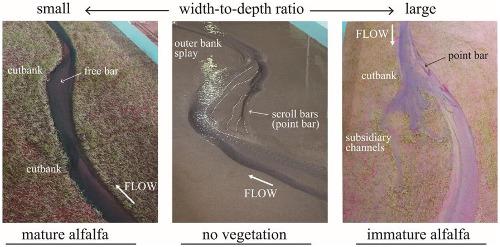当前位置:
X-MOL 学术
›
Earth Surf.Process. Land.
›
论文详情
Our official English website, www.x-mol.net, welcomes your feedback! (Note: you will need to create a separate account there.)
Morphodynamic effects of vegetation life stage on experimental meandering channels
Earth Surface Processes and Landforms ( IF 3.3 ) Pub Date : 2020-12-14 , DOI: 10.1002/esp.5051 Tomoko Kyuka 1 , Satomi Yamaguchi 2 , Yusuke Inoue 1 , Kattia Rubi Arnez Ferrel 1 , Hideto Kon 1 , Yasuyuki Shimizu 1
Earth Surface Processes and Landforms ( IF 3.3 ) Pub Date : 2020-12-14 , DOI: 10.1002/esp.5051 Tomoko Kyuka 1 , Satomi Yamaguchi 2 , Yusuke Inoue 1 , Kattia Rubi Arnez Ferrel 1 , Hideto Kon 1 , Yasuyuki Shimizu 1
Affiliation

|
Previous studies have demonstrated that riparian vegetation leads to channel transformation from a multi‐bar to a single‐thread channel planform. However, it still remains unclear how the presence of pioneer and mature vegetation affects the morphodynamics of single‐thread meandering rivers. In this study, we therefore investigated the effects of vegetation strength on the morphodynamic evolution of an experimental meandering channel. Three physical laboratory experiments were conducted using alfalfa sprouts in different life stages – no vegetation, immature vegetation, and mature vegetation – to simulate different floodplain vegetation strengths. Our results demonstrate that vegetation plays a key role in mediating bank erosion and point‐bar accretion, and that this is reflected in both the evolution of the channel bed as well as the sediment flux. The presence of mature vegetation maintained a deep, single‐thread channel by reducing bank erosion, thereby limiting both channel widening and sediment storage capacity. Conversely, an unvegetated floodplain led to channel widening and high sediment storage capacity. Channel evolution in the unvegetated scenario showed that the active sediment supply from outer bank erosion led to slightly delayed point‐bar accretion on the inner banks due to helical flow, deflecting the surface flow toward the outer banks and causing further erosion. In contrast, in the immature vegetation scenario, the outer banks were also initially eroded, but point‐bar accretion did not clearly progress. This led to a greater width‐to‐depth ratio, resulting in a transition from a single‐ to a multi‐thread channel with minor flow paths on the floodplain. The experimental results suggest that the eco‐morphodynamic effects of young (low‐strength) and mature (high‐strength) vegetation are different. Notably, low‐strength, early‐stage vegetation increases channel complexity by accelerating both channel widening and branching, and therefore might promote the coexistence of multi‐bars and pioneer vegetation.
中文翻译:

植被生命期对实验曲折河道的形态动力学影响
先前的研究表明,河岸植被导致河道从多条河道向单线河道转变。但是,尚不清楚先驱和成熟植被的存在如何影响单线蜿蜒河流的形态动力学。因此,在这项研究中,我们研究了植被强度对实验曲折河道形态动力学演化的影响。使用不同生命周期的苜蓿芽(无植被,未成熟植被和成熟植被)进行了三个物理实验室实验,以模拟不同的洪泛区植被强度。我们的结果表明,植被在调解河岸侵蚀和点坝增生方面起着关键作用,而且这既反映在河床的演变,也反映在泥沙通量上。成熟植被的存在通过减少河岸侵蚀来维持深层的单线通道,从而限制了通道的拓宽和沉积物的存储能力。相反,无植被的洪泛区导致河道拓宽和高沉积物存储能力。在无植被的情况下,河道演变表明,由于螺旋流的作用,外岸侵蚀引起的活跃沉积物供应导致内岸的点坝积聚略有延迟,从而使地表流向外岸偏转,并引起了进一步的侵蚀。相比之下,在未成熟植被的情况下,外部河岸最初也受到侵蚀,但点-杆积聚并未明显进展。这导致更大的宽深比,导致从泛滥平原上的次要流动路径从单线程通道过渡到多线程通道。实验结果表明,年轻(低强度)和成熟(高强度)植被的生态形态动力效应是不同的。值得注意的是,低强度的早期植被通过加速河道加宽和分支而增加了河道的复杂性,因此可能促进多杆和先驱植被的共存。
更新日期:2020-12-14
中文翻译:

植被生命期对实验曲折河道的形态动力学影响
先前的研究表明,河岸植被导致河道从多条河道向单线河道转变。但是,尚不清楚先驱和成熟植被的存在如何影响单线蜿蜒河流的形态动力学。因此,在这项研究中,我们研究了植被强度对实验曲折河道形态动力学演化的影响。使用不同生命周期的苜蓿芽(无植被,未成熟植被和成熟植被)进行了三个物理实验室实验,以模拟不同的洪泛区植被强度。我们的结果表明,植被在调解河岸侵蚀和点坝增生方面起着关键作用,而且这既反映在河床的演变,也反映在泥沙通量上。成熟植被的存在通过减少河岸侵蚀来维持深层的单线通道,从而限制了通道的拓宽和沉积物的存储能力。相反,无植被的洪泛区导致河道拓宽和高沉积物存储能力。在无植被的情况下,河道演变表明,由于螺旋流的作用,外岸侵蚀引起的活跃沉积物供应导致内岸的点坝积聚略有延迟,从而使地表流向外岸偏转,并引起了进一步的侵蚀。相比之下,在未成熟植被的情况下,外部河岸最初也受到侵蚀,但点-杆积聚并未明显进展。这导致更大的宽深比,导致从泛滥平原上的次要流动路径从单线程通道过渡到多线程通道。实验结果表明,年轻(低强度)和成熟(高强度)植被的生态形态动力效应是不同的。值得注意的是,低强度的早期植被通过加速河道加宽和分支而增加了河道的复杂性,因此可能促进多杆和先驱植被的共存。



























 京公网安备 11010802027423号
京公网安备 11010802027423号